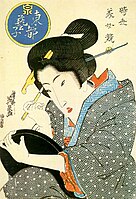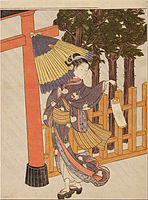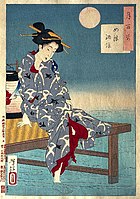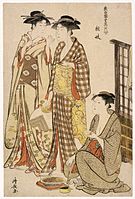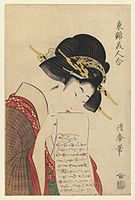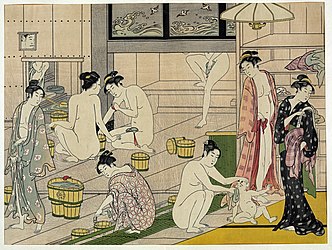Bijin-ga
This article includes a list of references, related reading, or external links, but its sources remain unclear because it lacks inline citations. (December 2014) |
| Three Beauties of the Present Day by Utamaro, 1793 | |
|---|---|
 | |
| Artist | Kitagawa Utamaro |
| Year | 1793 |
Bijin-ga (美人画, "beautiful person picture") is a generic term for pictures of beautiful women in Japanese art, especially in woodblock printing of the ukiyo-e genre, which predate photography.
Ukiyo-e is a genre of woodblock prints and paintings that was produced in Japan from the 17th century to the 19th century. These woodblock prints depicted beautiful women; kabuki actors and sumo wrestlers; scenes from history and folk tales; travel scenes and landscapes; flowers and animals and erotica. The prints were very popular amongst the Japanese merchants and the middle class of the time.
Nearly all ukiyo-e artists produced bijin-ga, it being one of the central themes of the genre. However, a few, including Utamaro, Suzuki Harunobu, Itō Shinsui, Toyohara Chikanobu, Uemura Shōen and Torii Kiyonaga, have been described as the greatest innovators and masters of the form.[citation needed]
Gallery
- Bijin-ga
-
Bijin-ga by Keisai Eisen (1790–1848)
-
Woman Visiting the Shrine in the Night by Suzuki Harunobu (1725–1770)
-
Shin Bijin, Shin Bijin series, No. 12 by Yōshū Chikanobu (1838–1912)
-
100 Aspects of the Moon by Yoshitoshi (1839–1892)
-
Two Women Standing from series "Tosai Yuri Bijin Awase", by Torii Kiyonaga (1752–1815)
-
Woman with cherry flowers by Tsukioka Yoshitoshi
-
A Girl About to Despatch a Letter, by Torii Kiyomine (1786–1868)
-
The Courtesan Someyama of the Matsubaya house, from the series: Contest of Beauties in the Gay Quarters, by Eishosai Choki - active from about 1786 to 1808.
-
Murasaki Shikibu, from the series "Mirror of Women, Ancient and Modern" (古今姫鏡), by Tsukioka Yoshitoshi (1839–1892)
-
Woman in the night, by Suzuki Harunobu, c. 1765–1770
-
Bathhouse women, by Torii Kiyonaga (1752–1815)
See also
Further reading
- Forbes, Andrew ; Henley, David (2012). Suzuki Harunobu: 100 Beauties. Chiang Mai: Cognoscenti Books. ASIN: B00AC2NB8Y
- Hamanaka, Shinji. Female Image: 20th Century Prints of Japanese Beauties. Hotei Publishing 2000. ISBN 90-74822-20-7

